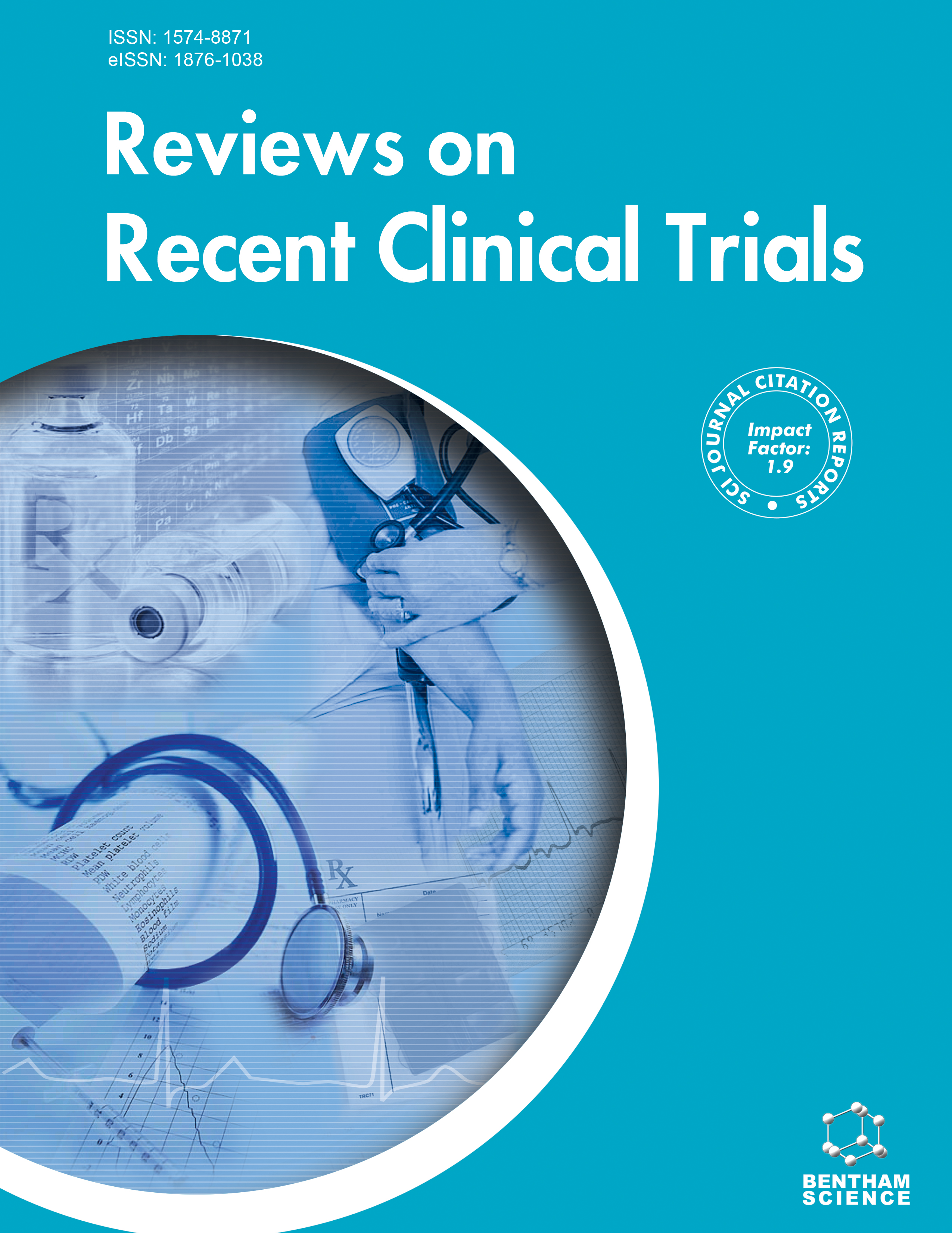- Home
- A-Z Publications
- Reviews on Recent Clinical Trials
- Previous Issues
- Volume 19, Issue 4, 2024
Reviews on Recent Clinical Trials - Volume 19, Issue 4, 2024
Volume 19, Issue 4, 2024
- Pharmacology, Clinical Trials
-
-
-
Is There an Association between 5a Reductase Inhibitors and Metabolic Syndrome? A Narrative Review of the Literature
More LessFinasteride and dutasteride are 5a Reductase Inhibitors (5a-RIs) and comprise the mainstay of treatment for the management of patients with benign prostatic hyperplasia. 5a-RIs are expressed in a variety of tissues, such as adipose tissues and liver, resulting in a reduction of glucocorticoid levels and affecting androgen regulation and metabolic function. As a result, the administration of these regimens m Read More
-
-
-
-
Systematic Review and Meta-analysis of the Impact of Metabolic Surgery on Hepatic Stiffness
More LessBackgroundBariatric surgery is one of the effective therapeutic options for people with obesity and obesity-related co-morbidities. In addition to weight-related co-morbid diseases, including diabetes, hypertension, and hypercholesterolemia, non-alcoholic fatty liver disease (NAFLD) is common in patients with morbid obesity. Bariatric surgery is one of the therapeutic options in the management of NAFLD. Hence, this re Read More
-
-
-
The Effects and Safety of Silymarin on β-thalassemia in Children and Adolescents: A Systematic Review based on Clinical Trial Studies
More LessBackgroundβ-thalassemia imposes significant complications on affected patients. Silymarin, a natural flavonoid complex, has potential therapeutic properties.ObjectiveThis systematic review aims to comprehensively evaluate the literature on the mechanistic effects of Silymarin on β-thalassemia outcomes in children and adolescents.MethodsA systematic search of electronic databases, including MEDLINE/PubMed, Em Read More
-
-
-
A Systematic Review and Meta-Analysis of the Effects of Statin Therapy on Heart Transplantation
More LessBackgroundMost of the mortality after Heart Transplantation (HT) is attributed to severe cardiac allograft vasculopathy (CAV) and rejection.ObjectivesThis meta-analysis aimed to investigate the effects of postoperative statin therapy on outcomes (mortality, rejection, and CAV in HT patients).MethodsThis systematic review and meta-analysis was performed on publications between 1980 and October 2023 in Web Read More
-
-
-
Development of Autoimmune Hepatitis after COVID-19 Infection in Vaccinated Women
More LessAuthors: Ilaria Lenci, Martina Milana, Luca Savino, Alessandro Signorello and Leonardo BaiocchiPurposeSARS-CoV-2 infection has been associated with the impairment of several organs, including the liver. In addition, cases of autoimmune hepatitis have been described in association with COVID-19 disease. According to some case reports, vaccination has also been suggested to elicit the immune liver disorder.Case DescriptionWe report on the case series of two middle-aged women developing COVID-19 infection desp Read More
-
-
-
Vanek's Tumour as a Rare Cause of Dyspeptic Syndrome in a Patient with Primary Biliary Cholangitis: A Case Report
More LessBackgroundInflammatory Fibroid Polyp (IFP), also known as Vanek’s tumour, is a rare mesenchymal gastrointestinal tumour, potentially causing a wide range of clinical manifestations (even though it can be completely asymptomatic) primarily related to the location of the formation. The available evidence suggests a fundamentally non-neoplastic behaviour of IFP.Case PresentationA 67-year-old female was presented with Read More
-
-
-
Safety and Efficiency of Anti-VEGF with Dexamethasone Intravitreal Implant for Non-Ischemic Retinal Vein Occlusion: A Prospective, Case-controlled, Cohort Study
More LessAuthors: Xiaohui Cai, Jing Zhao and Yalong DangObjectiveThis study aimed to assess the efficacy and safety of anti-VEGF combined with dexamethasone implant for the retinal vein occlusion patients with macular edema.MethodsIn this prospective, case-controlled, cohort clinical trial (Register ID: ChiCTR2400080048), patients with non-ischemic retinal vein occlusion were enrolled from the Sanmenxia Central Hospital from August 2020 to April 2023. The patients were ra Read More
-
Volumes & issues
-
Volume 20 (2025)
-
Volume 19 (2024)
-
Volume 18 (2023)
-
Volume 17 (2022)
-
Volume 16 (2021)
-
Volume 15 (2020)
-
Volume 14 (2019)
-
Volume 13 (2018)
-
Volume 12 (2017)
-
Volume 11 (2016)
-
Volume 10 (2015)
-
Volume 9 (2014)
-
Volume 8 (2013)
-
Volume 7 (2012)
-
Volume 6 (2011)
-
Volume 5 (2010)
-
Volume 4 (2009)
-
Volume 3 (2008)
-
Volume 2 (2007)
-
Volume 1 (2006)
Most Read This Month
Article
content/journals/rrct
Journal
10
5
false
en

Most Cited Most Cited RSS feed
-
-
-
COVID-19 Vaccinations: Summary Guidance for Cancer Patients in 28 Languages: Breaking Barriers to Cancer Patient Information
Authors: Davide Mauri, Konstantinos Kamposioras, Lampriani Tsali, Mario Dambrosio, Berardino De Bari, Nadia Hindi, Carl Salembier, Joanna Nixon, Tzachanis Dimitrios, Flippo Alongi, Hassan Hameed, Antonios Valachis, Konstantinos Papadimitriou, Stefanie Corradini, Lazar Popovic, Jindrich Kopecky, Andres Rodriguez, Katarina Antunac, Junlin Yi, Jozsef Lovey, Primoz Strojan, Haytham Saraireh, Ranveig Røtterud, Marzanna Chojnacka, Santa C. Olalla, Natalia Chilingirova, Ramon Andrade De Mello, Giovanna Araujo Amaral, Farsid Arbabi, Radu Vidra, Erjeta Rapushi, Dan Takeuchi, Chirstos Christopoulos, Irina Ivanova, Igor Djan, Branka Petricevic, Francesco Cellini, Iglika Mihaylova, Natalija Dedic Plavetic, Cvetka Grašič Kuhar, Elena Takeuchi, Pantelis Kountourakis, Panagiotis Ntellas, Ioanna Gazouli, Stefania Gkoura, Salih Yuce, Özlem ER, Chait Yasmina, Gireesh Kumaran, Orges Spahiu, Aasim Yusuf, Paulina Gono, Kathi Apostolidis and Maria Tolia
-
-
-
-
Deep Neck Infections: Decisional Algorithm for Patients with Multiple Spaces Involvement
Authors: Filippo Ricciardiello, Salvatore Mazzone, Pasquale Viola, Gianluca Guggino, Giuseppe Longo, Alberto Napolitano, Giuseppe Russo, Giulio Sequino, Flavia Oliva, Pasquale Salomone, Marco Perrella, Giovanni M. Romano, Pietro Cinaglia, Teresa Abate, Maurizio Gargiulo, Davide Pisani and Giuseppe Chiarella
-
- More Less

